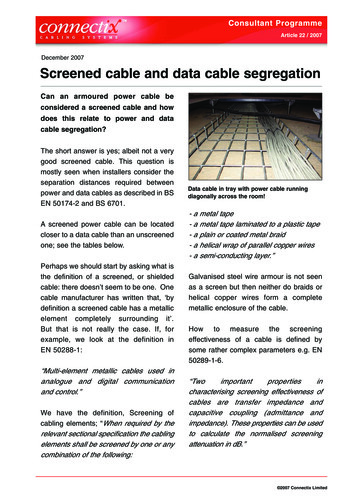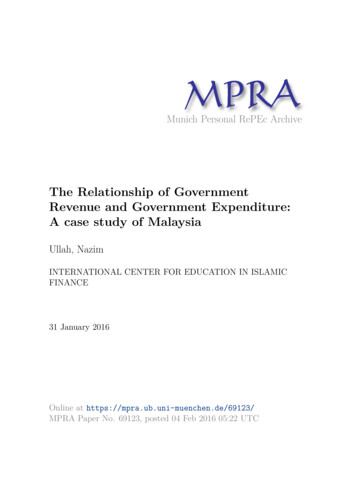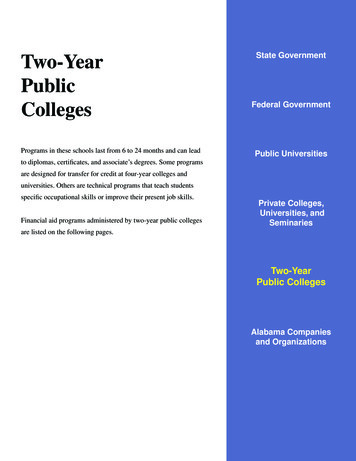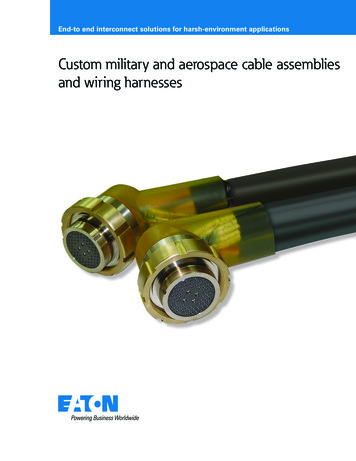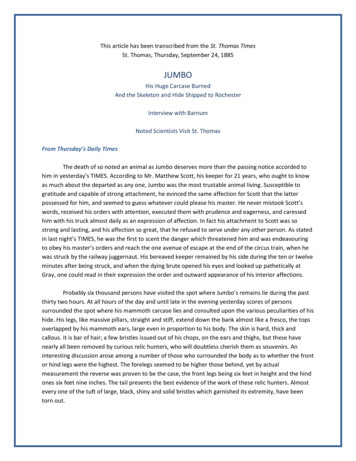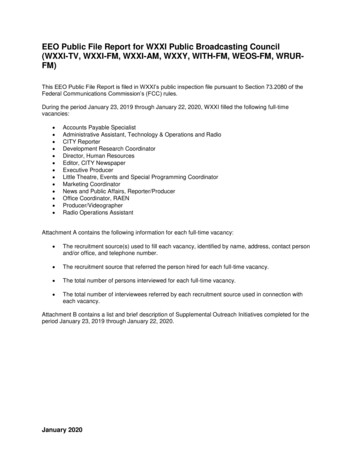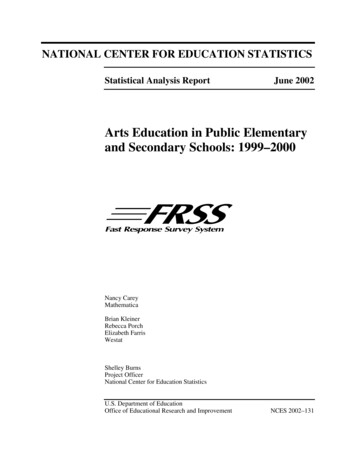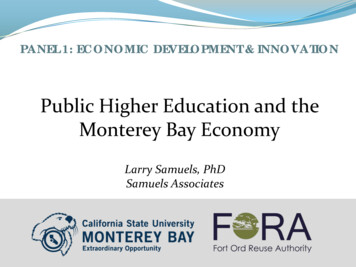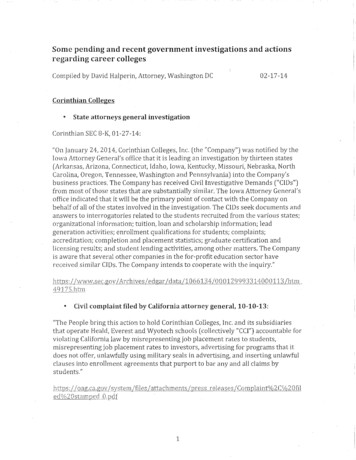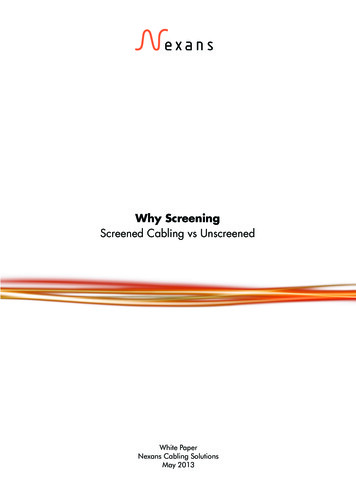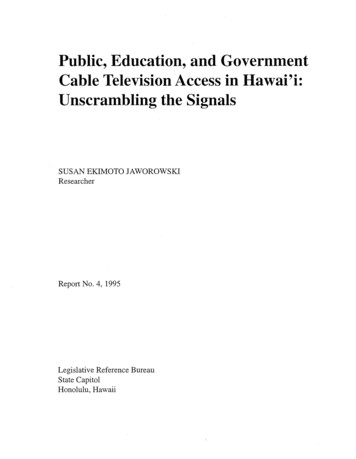
Transcription
Public, Education, and GovernmentCable Television Access in Hawai'i:Unscrambling the SignalsSUSAN EKIMOTO JAWOROWSKIResearcherReport No.4, 1995Legislative Reference BureauState CapitolHonolulu, Hawaii
FOREWORDThis study was prepared in response to Senate Resolution No. 65, Senate Draft 1(1995). The Resolution directed the Legislative Reference Bureau to study the nonprofitpublic, education, and government cable access organizations in Hawai'i to determinewhether their operations provide the type of access and programming intended by federal andstate law.The Bureau was also directed to answer specific issues related to theirmanagement, funding, and operation.The Bureau wishes to extend its appreciation to all those who assisted in the study,including the respondents from other access organizations across the United States and inCanada. The Bureau extends special thanks to Sue Buske, Kathleen Schuler, SanfordInouye, Ras Skelton, Darla Palmer, Richard Turner, Juergen Denecke, Brian Lee, WendyArbeit, Bruce Fisher, Prema Qadir, Carol Bain, Ed Coil, Andy Park, and Robbie Aim for theircooperation and assistance.Wendell K. KimuraActing DirectorNovember 1995ii
TABLE OF CONTENTSPageFOREWORD .,1.iiINTRODUCTION .Nature of the Study . .Objective of the Study . .Organization of the Study . .2.BACKGROUND .2The PlayersTheTheTheTheFederal Government .State.Cable Companies . . . . . . . . .Access Organizations.2233Interconnections between the State, the CableCompanies, and the Access Organizations3.4.Other Issues.Endnotes .66'OLELO: THE CORPORATION FOR COMMUNITY TELEVISION . .9Background . . . .Training .Equipment and Facility Availability. . . .Cablecast Access.Editorial Guidelines. . . .Promotion.Viewership.Budget .Board Membership. . . .What the State Can Do to Help Meet PEG Access Goals. . .Public Comments on 'Olelo.Endnotes.991920HO'IKE: KAUA'I COMMUNITY TELEVISION . .22Background . . .Training. . . .Equipment Availability .Cablecast Access.Editorial Guidelines. . . . .iii12151617171818182223242425
5.6.7.Promotion.Viewership . ,. ,.Budget .Board Membership. .What State Could Do to Assist Public Access. . . .Guidelines to Restrict Potential Abuse of G Channel.Public Comments. .Endnotes.2626262727272829AKAKU: MAUl COMMUNITY TELEViSiON . .30Background. .Training. . .Equipment Availability .Cablecast Access.Editorial Guidelines. .Promotion.Viewership.Cablecast Scheduling. .Budget .Board Membership .Community Access to Channels.Endnotes. . .303131323333333334353636NA LEO '0 HAWAI'I, INC . .37Background. . . .Training . '" . . . .Equipment Availability .Broadcast Access .Editorial Guidelines . .Promotion. . . . . . .Viewership. . . . .E & G Programming. .Budget .Proposed Insurance Deposit and Fees .Board Membership. . . .What Could the State Do to Try to Help Na Leo Meet PEG Goals.What the State Can Do to Help Na Leo Promote the G Function .Public Comments. . . .Endnotes. .373737383838393939393940404141WHAT TYPE OF ACCESS SHOULD BE PROVIDED? . .42Speakers' Access to Technology.Access to the Medium. . . .The Community's Access .4546Endnotes. . .461.2.3.iv43
Page8.BOARD SELECTION . .48Proponents of Board Selection.Criticism of Current Selection Process.50511.2.3.4.5.6.9.No Subscriber Representation . .No Producer Representation. . .No Election of Board Members.Removal from Local Community .State Appointments.Cable Company Appointments . :.515252535354Other Models.Analysis.Summary.Endnotes . . . . . . .54585861FINDINGS AND RECOMMENDATIONS . .64General Findings.Findings Concerning the Access Organizations.Conclusions of Relevance to the State . . . . . . .Conclusions Concerning the Access Organizations. .64666870APPENDICESSenate Resolution No. 65, The Senate, Eighteenth Legislature, 1995 RegularSession, State of Hawaii .72Letter from Sanford T. Inouye, Cable Television Division, Department ofCommerce and Consumer Affairs . . . . . . . . .75C.Letter from Richard D. Turner, Executive Director, 'Olelo.78D.Letter from Dr. Keola G.A. Downing, President, Na Maka '0 Hilo .85A.B.v
Chapter 1INTRODUCTIONNature of the StudyThe Senate of the Eighteenth Legislature of the State of Hawaii, Regular Session of1995, adopted Senate Resolution No. 65, S.D. 1, entitled, "Requesting the LegislativeReference Bureau to study Hawaii's non-profit cable public access corporations to ensure thattheir operations are consistent with PEG access goals." A copy of the Resolution is containedin Appendix A.Objective of the StudyS.R. No. 65, S.D. 1, requests the Bureau to determine:(1)If local cable access corporations provide that type of access and programmingintended by federal and state law;(2)Whether the methods of choosing the local cable access corporations' boardmembers should be changed to include the votes of local cable subscribers;(3)How the money is allocated to each of the three PEG elements (public,education, and government), and how that money is budgeted for production,overhead, and administration;(4)Whether the current training requirements meet the demand for training andpersonnel; and(5)Any guidelines necessary to ensure that public officials do not abuse access.Organization of the StudyThis study is organized into nine chapters. Chapter two delineates the entitiesinvolved in public access television and their interrelationships. Chapter three describes'Olelo, the access organization for the city and county of Honolulu; chapter four discussesHo'ike, the access organization for the county of Kaua'i; chapter five looks at AkakiJ, theaccess organization for the county of Maui; and chapter six covers Na Leo '0 Hawai'i, theaccess organization for the county of Hawaii. Chapter seven examines the legislative historyof the public access television laws and discusses its three components. Chapter eight setsout and discusses the issue of board selection. Chapter nine contains the Bureau's findingsand recommendations.1
Chapter 2BACKGROUNDIn Senate Resolution No. 65, S.D. 1, the Legislature sought answers to five specificquestions. In researching the issues, it became apparent that the answers would notilluminate the picture without adequate background. A significant part of this study will be adescription of the issues and the structure and operations of the access organizations. Thischapter describes the interrelationship between the federal and state cable television accesslaws and between the three major entities involved: the State, through the Department ofCommerce and Consumer Affairs (DCCA), the cable companies, and the accessorganizations. The issue of what type of access is intended by the law will be reviewed.Chapters 3 through 6 will review the structure and functions of each of the four accessorgan izations.It should be stressed that this study is intended to address policy issues, and is not anaudit of the public access organizations. Some people who contacted the Bureau inconnection with the study reported issues relating to alleged problems such as purchase ofthe wrong equipment, improper use of facilities, and improper installation of equipment.These are not the issues relevant to the resolution. This study represents an examination ofthe philosophy behind public access, whether the access organizations are fulfilling theirmission, and answers specific questions requested by the Legislature.The PlayersThere are four entities involved in this topic.The Federal GovernmentThe federal government, through the Federal Communications Commission (FCC),regulates the cable industry. Between 1972 and 1979, the FCC required PEG (public,education, and government) programming for the larger franchise areas. That requirementwas struck down in 1979. In 1984, Congress passed the Cable Communications Policy Act of1984 (1984 Act), in which the franchising authorities of the cable companies were permitted,but not mandated, to require their franchisees (Le., the cable companies) to provide PEGaccess.The StateIn most locales, the franchising authority is at the county level or lower. In Hawaii, theState has taken on that function. Under chapter 440G, Hawaii Revised Statutes, the Staterequires its franchisees, the cable companies, to provide PEG access as a condition ofgranting the franchise. The Department of Commerce and Consumer Affairs (DCCA) is thestate agency that handles the franchise agreements.2
BACKGROUNDThe Cable CompaniesThe cable companies are the private entities that provide cable television service totheir subscribers. At the time this study was prepared, those providers were: on O'ahu,Oceanic Cablevision 1 and Chronicle Cablevision of Hawaii; on the Big Island, Jones Spacelinkof Hawaii, Inc., Sun Cablevision of Hawaii and Kamehameha Cablevision Cable Systems,2and Chronicle; on Maui, Chronicle and Hawaiian Cablevision Company;3 and on Kaua'i,Garden Isle Cablevision and Kauai Cablevision. As discussed in detail below, the cablecompanies each pay a small portion of their annual gross revenue to fund the cable accessorganizations.The Access Organizations"PEG accessThe access organizations are known by several descriptions:organizations", "nonprofit cable access organizations", and "access centers". This study willrefer to them as the "access organizations". This term refers to the private, nonprofitcompanies set up solely to handle the PEG obligations of the cable companies. Theseaccess organizations are intended to be independent; they are not intended to be stateagencies and they are not affiliated with the cable companies. On O'ahu, the accessorganization is 'Olelo: The Corporation for Community Television; on Maui, Akako: MauiCounty Community Television, Inc.; on Kaua'i, Ho'ike: Kauai Community Television; and onthe Big Island, Na Leo '0 Hawai'i.Each of these organizations has a written or oral contract with the State by which theyagree to provide PEG services (or in the case of Maui, P services only).The federal act is silent on the role of access organizations, as Congress did notanticipate their existence. 4 The Act does provide that cable companies may be required, ineach twelve-month period, to pay the franchising authority a franchise fee of not more thanfive percent of gross revenues. 5 However, the legislation does not provide instruction on theuse of the fee. The federal legislation also indicates that the cable companies can berequired to make capital contributions to the access organizations, which are not included inthe five percent franchise fee limit.Neither the state statutes nor state rules directly mention this franchise fee, althoughthe statute refers to conditions that the Director of Commerce and Consumer Affairs mayplace on franchisees, and also specifies that each cable operator shall pay an annual fee, tobe determined by the Director, to offset the costs of administering the state law. 6The franchise fees are mentioned explicitly in the Decisions and Orders that constitutethe contract between the State and the cable operators. At the time this study wasrequested, 'Olelo was receiving three percent of the gross revenues and, for the most part,the neighbor island access organizations were receiving only two percent. 7 The situation haschanged since that time, as documented in a letter from the Cable Television Division of theDCCA, included as Appendix B. Most of the neighbor island access organization now haveaccess to three percent. Ho'ike's agreement will change as of 1996 but it will not receivepayment at the three percent rate until the end of 1996. See Appendix B. This change isappropriate; the neighbor island access organizations have been operating on a comparativeshoestring due to their much smaller subscriber bases. While they cannot expect the kind ofrevenues and facilities that 'Olelo has, the disparity in resources is marked. While 'Olelo hassufficient resources with which to purchase its own building, two of the neighbor islandorganizations cannot even afford to rent enough space for a small studio. As they lack the3
PEG ACCESSeconomies of scale that a large organization such as 'Olelo enjoys, equity would seem todemand that they receive at least the same percentage as 'Olelo.In addition to the two to three percent paid to the access organizations, the cablecompanies are required to pay to the DCCA one percent of their gross revenues for itsoperating expenses. Another one percent of gross revenues has been designated in somefranchise areas for the Hawaii Public Broadcasting Authority (HPBA). This means thatOceanic, for example, is at its maximum 5 percent franchise fee capacity: 3 percent to PEGaccess, 1 percent to DCCA, and 1 percent to HPBA.While the federal act is silent as to the uses of the franchise fee, paying a portion toHPBA is problematic. HPBA's mission is to establish and operate public broadcastingfacilities, to produce or obtain programs intended to enlighten the people of the State, and toair these programs. 8 HPBA, which is also within the DeCA, is intended to be funded by arevolving fund, the sources
and Chronicle; on Maui, Chronicle and Hawaiian Cablevision Company;3 and on Kaua'i, Garden Isle Cablevision and Kauai Cablevision. As discussed in detail below, the cable companies each pay a small portion of their annual gross revenue to fund
